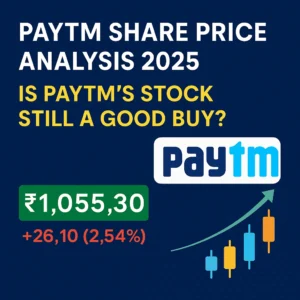Physical Address
South Garohills Megahalay
Physical Address
South Garohills Megahalay
Paytm Share Price Analysis 2025: Is Paytm’s Stock Still a Good Buy? Paytm (One97 Communications) has surged over 120% in the past year, crossing the crucial ₹1,000 level and touching new 52-week highs. But can the fintech giant sustain this impressive recovery, or is a correction likely?

Paytm (One97 Communications) has staged an extraordinary comeback in the Indian stock market over the past year. The fintech giant’s stock price has surged over 120% in just 12 months, reclaiming the psychologically crucial ₹1,000 level and touching fresh 52-week highs.
As of late July 2025, Paytm’s share price is trading between ₹1,020 and ₹1,050 on major exchanges, signaling strong investor confidence ahead of its Q1 FY26 results. This resurgence comes after years of underperformance following its overhyped IPO.
Current Price: ₹1,020 – ₹1,055 (as of July 22, 2025)
52-Week Range: ₹437 – ₹1,063
1-Year Return: Over 122% gains, outpacing most fintech competitors
Market Cap: Approximately ₹67,000 crore
Performance vs IPO Price: Still ~53% below its IPO issue price of ₹2,150, but recovering steadily
The recent rally is attributed to improved earnings expectations, regulatory clarity, and growing fintech adoption in India.
Paytm is expected to report a net profit of around ₹18–20 crore in Q1 FY26, marking its first profitable quarter. This shift from a net loss of ₹839 crore in the same quarter last year highlights the company’s improving operational efficiency.
The company’s revenue is estimated to have grown by 27–31% year-on-year, reaching nearly ₹1,950 crore. Analysts also expect Paytm to post a positive EBITDA margin (~1.1%), indicating that the company is inching closer to sustained profitability.
However, payment processing charges (PPC) are expected to rise to nearly 55% from ~50% last year, putting some pressure on margins. Investors are closely watching how the management addresses these costs in its upcoming earnings call.
After a prolonged regulatory tussle, Paytm was allowed to resume UPI onboarding via partner banks, including Yes Bank, HDFC, Axis, and SBI. This development significantly boosted merchant acquisition and payment volumes.
The regulatory clarity has not only restored investor confidence but also opened doors for Paytm to aggressively expand its merchant lending and financial services business.
Technical indicators show strong momentum in Paytm’s stock:
Chart Patterns: A combination of higher highs, higher lows, and bullish patterns such as the cup-and-handle and inverted head-and-shoulders is visible.
Resistance Levels: ₹1,020–₹1,050 remains a crucial breakout zone. A clean breakout above ₹1,060 with high volume could push the stock towards ₹1,100–₹1,200 in the near term.
RSI & Moving Averages: The Relative Strength Index (RSI) is around 65, indicating bullish momentum without being overbought. The stock also trades well above its 50-day and 200-day moving averages.
Several brokerage firms have turned bullish on Paytm:
Analysts expect the stock to reach ₹1,100–₹1,200 in the short to medium term if Q1 results meet expectations.
The median analyst target is around ₹970, reflecting caution among some market participants.
| Strengths | Weaknesses |
|---|---|
| Strong 128% rally in one year | Negative EPS (-₹10.32 TTM) |
| Improving operational profitability | High valuation (P/S ~7.2, P/B ~4.3) |
| Resumed UPI onboarding, boosting volumes | Margins under pressure due to high PPC |
| Opportunities | Threats |
|---|---|
| Q1 profitability may trigger further rally | Regulatory uncertainties (RBI policies, UPI guidelines) |
| Expansion in loans, insurance, and cloud services | Market sentiment reversal if results disappoint |
| Rising fintech adoption in India | Competitive pressure from PhonePe, Google Pay, and others |
Paytm’s Q1 FY26 results, scheduled for July 22, are crucial for investors. Here’s what to watch:
Profitability Confirmation: A reported PAT above ₹15 crore would strengthen the bullish narrative.
Revenue vs Margin: Sustained revenue growth with controlled payment processing costs is key.
Management Commentary: Guidance on UPI monetization, merchant lending, and expense control will shape market sentiment.
If the results exceed expectations, Paytm could rally toward ₹1,200. However, any margin disappointments may trigger a short-term correction to ₹950–₹980.
Support Zone: ₹980–₹1,000
Immediate Resistance: ₹1,050–₹1,060
Breakout Target: ₹1,100–₹1,200
Stop-Loss for Traders: ₹980
Aggressive traders are looking for a breakout above ₹1,060, while conservative investors may prefer to wait for earnings confirmation before entering.
Despite its strong recovery, Paytm is still trading far below its IPO issue price of ₹2,150. For the stock to reclaim those levels, several conditions must be met:
Consistent profitability over the next few quarters
Successful monetization of UPI and merchant lending services
Stable regulatory environment
Expansion into high-margin businesses such as insurance, cloud services, and cross-border payments
If these factors align, Paytm could potentially trade above ₹1,400–₹1,500 within the next 12–18 months.
Enter around ₹1,020–₹1,030 on breakout confirmation, targeting ₹1,100–₹1,200 with a strict stop-loss at ₹980.
Wait for Q1 results and enter on dips if the company maintains profitability and revenue growth.
Avoid immediate entry. Reassess after two consecutive profitable quarters.
1. Why is Paytm’s stock rallying in 2025?
The rally is driven by expectations of Q1 profitability, regulatory clarity on UPI onboarding, and strong fintech adoption trends.
2. What is the short-term target for Paytm stock?
If the stock breaks above ₹1,060 with volume support, it could rally toward ₹1,100–₹1,200.
3. Is Paytm a good long-term investment?
Long-term potential exists, but consistent profitability, margin expansion, and regulatory stability are crucial.
4. What are the biggest risks?
Regulatory challenges, high payment processing costs, and competition from other fintech players are the primary risks.
Paytm’s strong comeback in 2025 marks a turning point for India’s fintech leader. With improving fundamentals, positive technical indicators, and a clear path to profitability, the stock is attracting investor attention again.
However, caution is advised—rising costs and regulatory uncertainty could derail its recovery. Investors should adopt a disciplined approach, focusing on technical breakouts and quarterly earnings before making long-term commitments.
© 2025 RostNeo. All rights reserved.